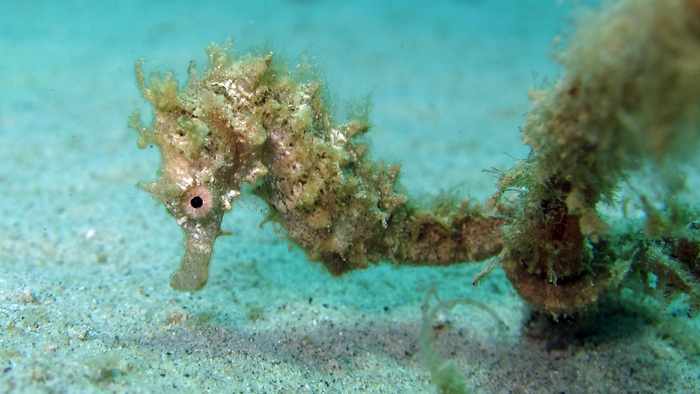Video Report: Evaluating the profits and costs of Thailand’s rampant seahorse trade

SPECIAL REPORT
Though not usually a fish specifically targeted by the fishing industry, an estimated 5.8 million seahorses are exported each year from Thailand, playing a large role in making the country the world leader in seahorse exports.
With seahorse catch numbers dwindling and the charismatic creatures being added to CITES, the eyes of the world turn to Thailand. The Gazette’s Isaac Stone Simonelli reports.
PHUKET: The majority of seahorses harvested from Thai waters are trawlers’ bycatch, fish that are not targeted but nevertheless caught in fishing gear.
“The captains of trawlers and boat owners are not interested in the seahorse product and they allow
the crews to collect and sell them to local traders for additional income,” Dr Parichart Laksanawimol,
Biology Lecturer at Rajabhat Chan-drakasem University said.
Most fishermen in Thailand say that the profits from seahorse sales comprise up to 20 per cent of their annual earnings.
“Trawler crews’ salaries range from 8,000 to 20,000 baht per month… The crew’s profit from the seahorse trade is not easy to calculate due to seahorses being non-target species.
“However, additional income for the crew ranges from 500 baht to 10,000 baht per month
depending on the fishing grounds and the season.
“Crew members usually do not share any profit from the seahorse trade. Each crew member collects and sells their seahorses individually,” Dr Parichart said.
Most commercial ports have seahorse buyers, explains Lindsay Aylesworth, lead researcher in Thailand for Project Seahorse and PhD candidate at the University of British Columbia.
Rassada Pier has several commercial vendors of seahorses. “Seahorses for sale” signs and dried specimens are easily found there, as are vendors willing to make a sale. However, none of them were willing to speak on record when approached by the Phuket Gazette.
Middle men and local buyers pay fishermen at the ports between five baht and 1,000 baht for seahorses based on their size, said Ms Aylesworth.
The price for seahorses then begins to increase by 50 per cent per following transaction.
A woman selling seahorses at Rawai Pier to tourists priced a dried specimen that was about 8cm long at 2,000 baht.
“Sometimes in the smaller scale [fishing] areas there seems to be a market for them, but in other places there are no markets,” said Ms Aylesworth, who has been interviewing fishermen in Thailand for the last year and half to better understand the trade.

Fishers in areas that have not developed a market for seahorses are returning the seahorses they find caught in their nets to the sea, said Ms Aylesworth.
“In some areas, there have been seahorse buyers for generations passing on [the trade] through family lines.
“In other cases, we’ve heard of entrepreneurial souls who have visited other places and seen that there are people selling them and say, ‘Ah, let’s see if I can catch some seahoreses and sell them to you.’
“And in some locations, there seems to be no history, no current market and no interest.”
Project Seahorse alumnus Allison Perry’s research, released in 2010, has shown a general decline in seahorse bycatch volumes.
“This raises concerns about the status of seahorse populations in these countries,” said the research paper, titled Fisheries, large-scale trade, and conservation of seahorses in Malaysia and Thailand.
If catch numbers are decreasing faster than demand or if demand is not decreasing at all, prices for seahorses could be on the rise.
“Such price increases would not normally be expected to drive changes in bycatch landings of a species, although at least one Thai trawler was known to specifically target seahorses, an unusual practice that could potentially spread if seahorse market values continued to climb,” the paper noted.
SEAHORSES, WHAT ARE THEY GOOD FOR?
The largest use for seahorses both domestically and internationally is for traditional Chinese medicine.
“Fishermen sell them to local buyers as dry individuals. Mostly they are used for traditional medicines. There is a history of seahorses being used for their curative powers – anything from swollen lymph nodes to arthritis or male fertility problems, because it’s the male seahorse that carries the babies,” said Ms Aylesworth.
Male seahorses are the only male in the animal kingdom known to give live birth, she noted.
“Usually what happens is you take the dried seahorse, grind it up into a powder and mix it with honey or some other herbs, and drink it as a tea,” said Ms Aylesworth.
Though Thailand is the number one exporter of seahorses, with major markets in Hong Kong, Taiwan, China, Japan, South Korea and Singapore, it also has a strong domestic market.
At least an estimated 520 kilograms are consumed annually as traditional Chinese medicine.
Some respondents in Ms Perry’s research felt that traditional Chinese medicine was losing popularity, at least in Thailand, with younger generations opting for Western medicines more often. However, global trends suggest that consumption of herbal remedies has been increasing, according to a World Health Organization study in 2005.
LETTER OF THE LAW
Though many divers and even some seahorse sellers believe the trade is illegal, it is not.
In 2004, seahorses were one of the first fish species added to Appendix II of the Convention on International Trade in Endangered Species of Wild Fauna and Flora (CITES), which demands that countries maintain “sustainable trade” and monitor populations.
“It’s still legal to trade dead seahorses inside the country, whereas seahorse exports have to have a permit from CITES authorities in Thailand,” said Dr Parichart.
International trade in specimens of Appendix-II species may be authorized by the granting of an export permit or re-export certificate.
“Permits or certificates should only be granted if the relevant authorities are satisfied that certain conditions are met, above all that trade will not be detrimental to the survival of the species in the wild,” explained Dr Parichart.
Though there are no specific laws in place in Thailand to protect seahorses, there are several laws that indirectly control seahorse catches, such as no fishing zones, no fishing during spawning season in some areas and no fishing with non-selective trawlers within 5,400 meters of the shore, said Dr Parichart.
“Any non-selective trawler will commonly damage benthic organisms [live on, in, or near the seabed], as well as seahorse habitats,” Dr Parichart said.
However, it is difficult to enforce the law at sea, said Department of Marine and Coastal Resources (DMCR) Region 5 Chief Tanet Munnoy, who earlier this year asked for the public to help document illegal fishing in marine sanctuaries and national parks (story here).
“It is very difficult for us to catch illegal fishermen, as we have no way to keep from being seen as we approach them. And we have to catch them in the act in order to make an arrest,” Mr Tanet said at the time.
Another challenge facing the fishing industry are regulations concerning the size of the mesh in nets.
“I know that the Department of Fisheries has passed laws about meshing sizes that they encourage… for sustainability of different populations of targeted fish, because in theory, larger mesh sizes don’t catch juvenile
— Isaac Stone Simonelli
Latest Thailand News
Follow The Thaiger on Google News:


























